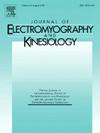运动生活方式对腰椎体内被动僵硬的影响。
IF 2.3
4区 医学
Q3 NEUROSCIENCES
引用次数: 0
摘要
腰椎的被动僵硬对一个人受伤和脊柱不稳定的风险有直接的影响。因此,我们评估了体育活动生活方式对腰椎被动僵硬的影响。在完成一份体力活动问卷后,参与者被分为活跃组(n = 20)和不活跃组(n = 21)。被动式腰椎屈曲和伸展试验在定制的被动式夹具上完成。确定参与者的力矩-角度曲线,并通过将曲线划分为三个线性刚度增加区域来分析他们的腰椎被动刚度。无运动组弯角曲线低刚度区刚度显著降低(p = 0.014)。此外,坐在办公椅上的时间显著地预测了所有参与者的低刚度区域的刚度(p = 0.011)。这些发现表明,体育活动的生活方式可能是一种潜在的途径,通过这种途径,一个人的腰椎被动僵硬可能会增加,从而改善脊柱的健康和稳定性。本文章由计算机程序翻译,如有差异,请以英文原文为准。
The effect of physical activity lifestyle on in-vivo passive stiffness of the lumbar spine
The passive stiffness of the lumbar spine has direct implications on one’s risk of injury and spinal instability. Therefore, the effects that physical activity lifestyle may have on the lumbar spine’s passive stiffness was assessed. Participants were classified as active (n = 20) or inactive (n = 21) after completing a physical activity questionnaire. Passive lumbar flexion and extension trials were completed on a custom passive jig. The participant’s moment–angle curves were determined, and their lumbar spine passive stiffness was analyzed by partitioning the curve into three linear stiffness regions of increasing stiffness. Stiffness in the low stiffness zone of the moment–angle curve was significantly lower in the inactive group (p = 0.014). Furthermore, time spent sitting in an office chair significantly predicted the stiffness in their low stiffness zones across all participants (p = 0.011). These findings suggest that physical activity lifestyle may be a potential avenue through which one’s lumbar spine passive stiffness may increase, improving spinal health and stability in the population.
求助全文
通过发布文献求助,成功后即可免费获取论文全文。
去求助
来源期刊
CiteScore
4.70
自引率
8.00%
发文量
70
审稿时长
74 days
期刊介绍:
Journal of Electromyography & Kinesiology is the primary source for outstanding original articles on the study of human movement from muscle contraction via its motor units and sensory system to integrated motion through mechanical and electrical detection techniques.
As the official publication of the International Society of Electrophysiology and Kinesiology, the journal is dedicated to publishing the best work in all areas of electromyography and kinesiology, including: control of movement, muscle fatigue, muscle and nerve properties, joint biomechanics and electrical stimulation. Applications in rehabilitation, sports & exercise, motion analysis, ergonomics, alternative & complimentary medicine, measures of human performance and technical articles on electromyographic signal processing are welcome.

 求助内容:
求助内容: 应助结果提醒方式:
应助结果提醒方式:


